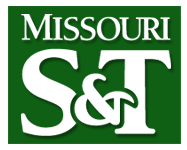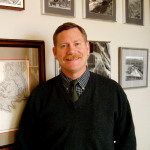Research Opportunities
in Natural Hazards
Evaluation and Mitigation, G.I.S, and Geoforensics
At the University
of Missouri-Rolla
The University of Missouri-Rolla has recently established an Interdisciplinary Center for Natural Hazards Mitigation. The focus of this center is to encourage multidisciplinary research teams to evaluate natural hazards and develop mitigation strategies and techniques for dealing with the risks they pose to society. To date, this work has included:
Identifying and Evaluating Natural Perils
• Earthquake induced phenomena, including: site response variances, liquefaction, clastic dikes, lateral spreading, landslides, dynamic compaction, surface fault rupture, lurching, soil-structure interaction, structural response of critical facilities, such as bridges, dams, levees, and civil engineering infrastructure.
• Mass wasting phenomena, including: slope creep, rock toppling, buckling failures, rotational and translational landslides, earthflows, debris flows, landslide dams, seismically-induced landslides, catastrophic Rockfalls (sturzstroms), ancient or dormant bedrock landslides, gravity-glide blocks, retrogressive and progressive slope failures, and sub aqueous landslides and turbidity channel deposits.
• Rock slope stability phenomena, including: influence of exfoliation and near-surface secondary jointing on slope stability, dam abutments, reservoir shorelines, tunnels, underground openings and excavations and fill placement for highways and railroads.
• Ground settlement phenomena, including: primary and secondary consolidation of saturated soil mixtures; hydrocompression of low cohesion silt and clay mixtures (both natural and man-placed); compaction of unconsolidated and partly-saturated sediments; solution-induced subsidence and collapse features; petroleum and groundwater withdrawal-induced settlement; mining-induced subsidence; and piping failures of subsurface drains and aquifers.
• Flooding problems, including: failures of dams and flood protection levee systems; statistically-infrequent precipitation events; sediment bulking in turbid flows; impact of transient bedload; channel scour around bridge supports during high flow; in-stream mining impacts; diminished capacity of debris basins and retention structures; diminished channel capacity caused by flow constrictions and localized channel aggradation; sediment storage; and impacts of weather pattern, vegetation pattern and land use changes on channel response.
Current Projects
Include:
• Analysis and Date Determination of Composite Paleoslides in the Grand
Canyon and Colorado Plateau
• West Lost Trail Creek Sturzstrom: A Composite Landslide
• Earthquake-Induced Lateral Spreads In The Western New Madrid Seismic
Zone
Developing New Mitigation Schemes
• For Earthquakes: GIS-hazard mapping of various perils, including 3-D information and estimates; site characterization using electronic piezometric Cone Penetrometer Soundings; measurement of dynamic properties using cross-hole shear wave devices; 1-D dynamic site characterization using synthetic earthquake records to evaluate potential impacts of impedance contrasts and incoherence on site response; Insitu densification of liquefiable sands and silts; new methods of subdrainage using prefabricated wick drains; installation of rock columns; pressure and micro jet grouting.
• For Mass Wasting: GIS-hazard mapping of all types of landslides, using conventional reconnaissance mapping, stereo pair aerial photographs and stereo pair terrestrial photos; development of topographic algorithms on digital elevation models, spatially corrected digital aerial imagery and synthetic aperture radar images.
• For Rock Slope Stability: insitu mapping techniques to discern face-parallel fracture spacing and aperture; impression packers; electronic downhole logging devices; terrestrial photogrammetry, digital imaging methods, and geophysical techniques.
• For Ground Settlement: enhancement of water content and input compaction energy at time of placement; fluid injection strategies; insertion of stabilizing additives using high pressure water jets; insertion of prefabricated wick drains; electronic monitoring of subsurface water content and automating water balance characteristics.
• For Flooding: development of new failure mechanisms for levees situated on pervious foundations which incorporate considerations of flow-induced static liquefaction and bearing-capacity-induced slope failure; validation testing using centrifuge models; development of insitu pore pressure gage alarms; development of inset and training levees in concert with set-back levees to replace existing single levee barriers; dismantling of debris basins and flood control structures which have become dysfunctional; developing new techniques for trapped sediment management.
Current Project(s) Include:
• Missouri River Bridges Seismic Site Response
Developing New GIS Reconnaissance
Methods
The department of Geological Engineering has operated and maintained a digital image processing laboratory in the School of Mines and Metallurgy since 1975. This lab has hardware and software for analyzing all types of multispectral and hyperspectral data, as well as digital elevation models, and traditional topography and geology. Activities in the lab have encompassed a variety of applications leading to the creation of map products for such purposes as mineral and petroleum exploration, land use planning, site characterization for construction and remediation, locating geological hazards, evaluating environmental hazards and stream and flood assessment.
Current Projects Include:
• Accurately Mapping Crowley’s Ridge with LiDAR Technologies
• Developing Landslide Detection Algorithms in Conjunction with DEMs Data.
Student Learning Cooperative with USGS - MCMC
• Program initiated by Professor Rogers in Fall 2001
• Students volunteer time in exchange for on-the-job-training in new GIS applications
• Students work hand-in-hand with ongoing projects at the MCMC
• Students are able to gain advanced training in Photogrammetry, Spectral Analysis and Spectral Library Creation, DEM creation, and other state-of-the-art mapping techniques
Applying Forensics Techniques to Geologic Failures
and Mishaps
Geoforensics is the use of geoscience principles to solve various mysteries involving earth and ocean systems. This includes applications to engineering failures as well as crimes involving our criminal justice system.
Natural physical processes are constrained by various bounding factors, such as the source rock or soil and various transport mechanisms; commonly controlled by gravity, density contrasts, cohesion/friction, magnetism, chemical affinity and suction forces. Most physical processes leave “geologic fingerprints” attesting to their origins, and each spot on the Earth is slightly different. By comparing the soil and rock fragments at one locale with the naturally-occurring environment we can often determine the most likely place a certain assemblage of material came from.
Current Projects Include:
• St. Francis Dam Outbreak Flood Mapping
• Historical Mapping of Alameda Naval Air Station
• Japanese Vengeance Bombs in World War II
• Sinking of RMS Titanic in April 1912
Department of Defense Projects
Current Projects Include:
• Underground Payload Emplacement Device Auger Optimization
Contact Information:
If you are interested in pursuing graduate study at the University
of Missouri-Rolla in natural hazards evaluation, assessment and mitigation,
please contact Professor Rogers at rogersda@umr.edu.
Research projects are available funded by various agencies, including the
Federal Highway Administration, Missouri Department of Transportation, U.S.
Bureau of Reclamation, National Science Foundation, and US Geological Survey.
Questions or comments on this page?
E-mail Dr. J David Rogers at rogersda@umr.edu.

